"Artist's Benefit -Commemorating the 120th Anniversary Art Exhibition of the Three Birthday of Zhu" opened at the Beijing Painting Academy Art Museum
Author:China Art College Time:2022.08.07

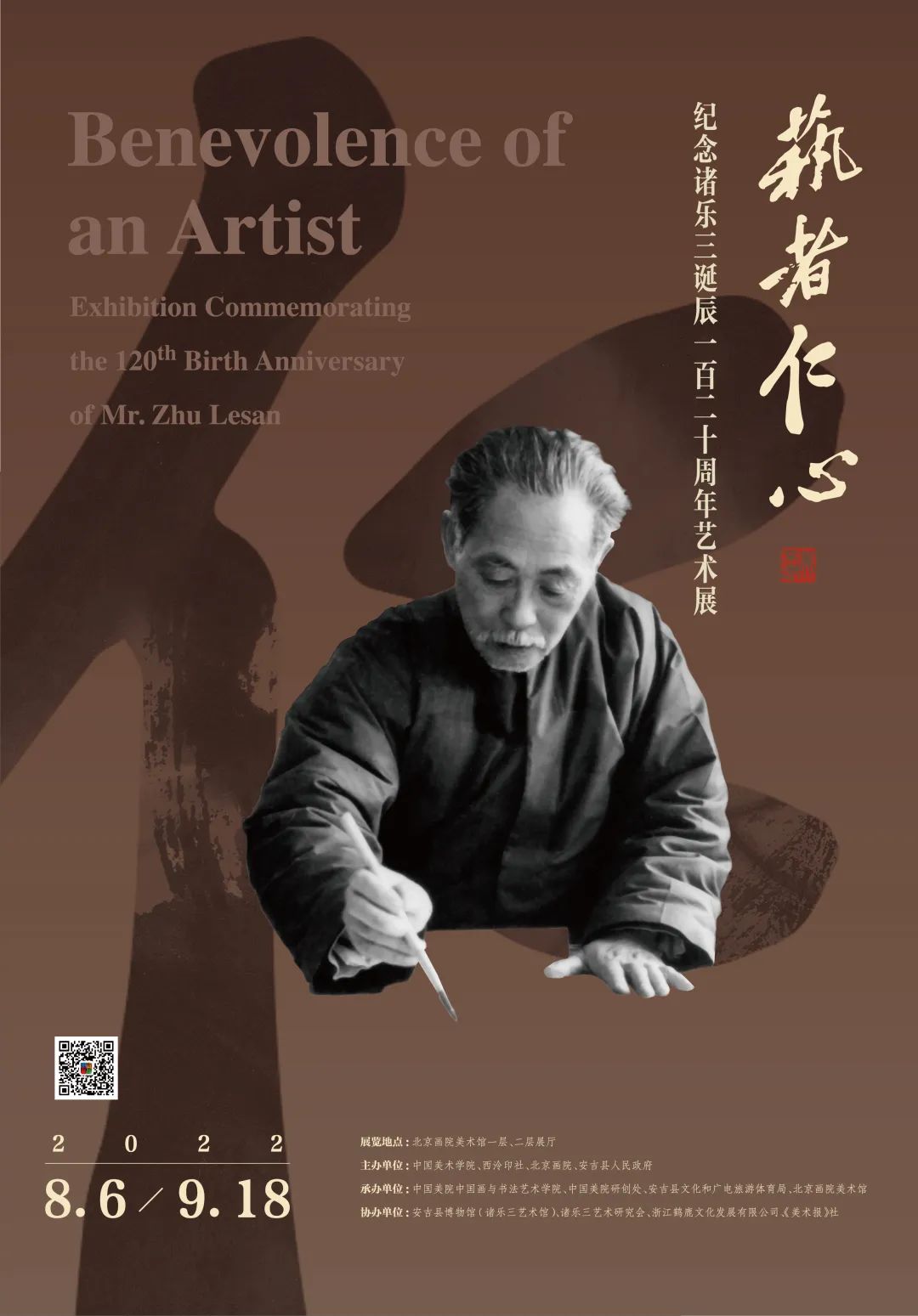
Exhibition time: August 6th to September 18, 2022
Exhibition location: The first and second floors of the Beijing Painting Academy Art Museum
Organizers: Chinese Academy of Fine Arts, Xiling Yinshe, Beijing Painting Academy, Anji County People's Government
Inheritance unit: Chinese Academy of Fine Arts and Calligraphy Arts, Research and Institute of Chinese Academy of Fine
Co -organizers: Anji County Museum (Zhu Le San Art Museum), Zhule Three Art Research Association, Zhejiang and Lu Culture Development Co., Ltd., "Art News"
On August 6, the first station of the first station of the Beijing Painting Academy Art Museum was jointly sponsored by the "Artist Benefit -Commemorating the 120th Anniversary of the Birthday of the Music Third Birthday of the Third Birthday of the Music" Essence
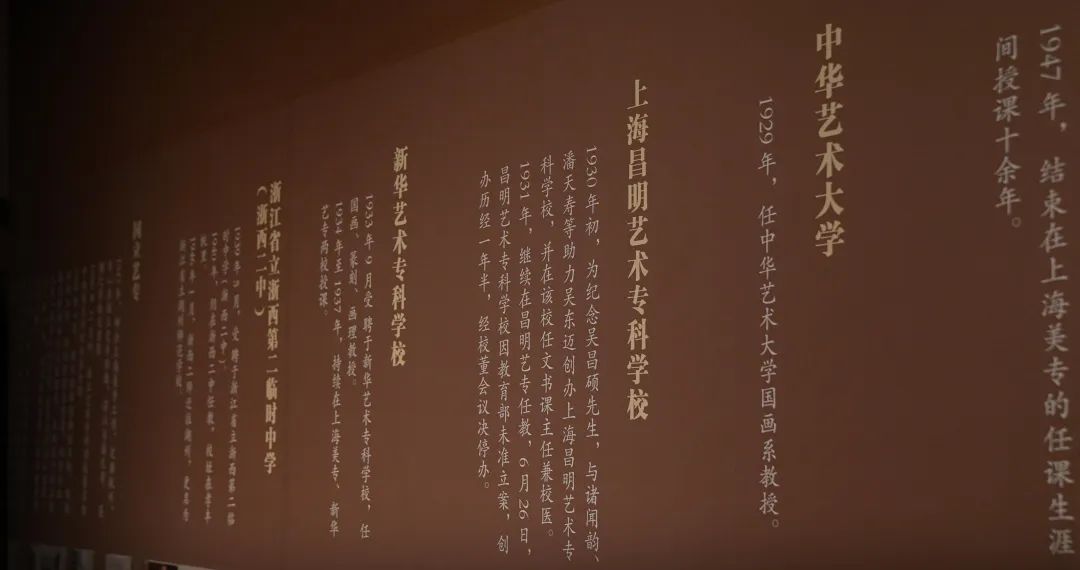
In July 1985, the "Zhule Three Painting and Calligraphy Carving Exhibition" was held in the Beijing China Art Museum. At that time, there were arts in the art community such as Wu Zuoren, Li Keran, Ye Qianyu, and Liu Kaiqu participated in the opening. In 2022, after 37 years, on the 120th anniversary of Mr. Musan's birthday, Mr.'s art came to Beijing again.

The exhibition was planned by Dean Wu Hongliang of the Beijing Academy of Painting and Professor Lu Yan of the Chinese Academy of Fine Arts. "" Mountains and Lingxiu Collection of wrist -calligraphy "," Boya Tongda Qiaoyi — engraving "," engraving "," use art as home peaches and Lifen -teaching ", and comprehensively review the creative experience and artistic life of Zhu Le San.

Mr. Zhu Le San was born in Helu Creek Village, Xiaofeng (now Anji), Zhejiang, and loves his hometown in his life. Throughout his life artistic creation, the paintings are commonly seen "filial piety and music", which shows that Mr. adheres to his original attitude of life. During the Anti -Japanese War, in addition to artistic creation, he used to save people in the countryside and did not get scores. After the founding of the People's Republic of China, it also led the Central Academy of Fine Arts East China Branch (now China Academy of Fine Arts) to go to the countryside to sketch the sketching of the topic of crops into artistic creation.

Mr. Zhu Le San is engaged in art education one -section, and he has been dedicated to the Chinese Academy of Fine Arts in Hangzhou. In the 1950s, Mr. Pan Tianshou, Wu Yanzhi and other gentlemen worked hard to coordinate with the leadership of the leadership and in -depth teaching. Today's Chinese Academy of Fine Arts) The reconstruction and development of the Department of Chinese Painting has laid the foundation. In 1963, Zhejiang Academy of Fine Arts opened the first undergraduate calligraphy engraving in the history of New China's higher art education, named "The Department of Calligraphy and Seal Carving of the Department of Chinese Painting Department of Zhejiang Academy of Fine Arts"; in 1979, Zhejiang Academy of Fine Arts also trained the first batch of graduate students of calligraphy and seal engraving in New China. As an important representative, Mr. Zhu Le San is responsible for engraving teaching and participating in it.
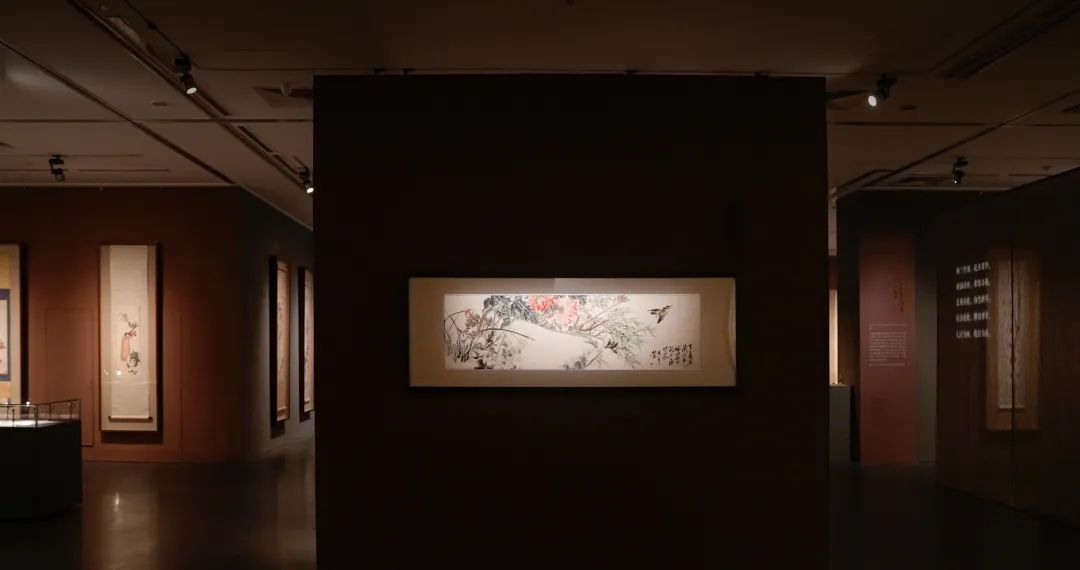
The series of "Artists' Benefit -Commemorating the 120th Anniversary Art Exhibition of the Third Birth of the Music" series of activities will also be held in the Anji Music Museum (Anji County Museum) and Hangzhou China Academy of Fine Arts. At the same time, the "Artists' Benefit -Zhu Le San Academic Symposium" and a series of lectures will be held.

At the same time, "Zhule Three Episodes · Flower and Bird Rolls" (Malaysia Kuan, Editor -in -Chief of Xu Jiachang), "Three Episodes of Zhu Le" (editor of Shen Hao and Lu Yan), "Three Episodes of Zhu Le" (Zhang Jie, Zhang Jie, Zhang Jie, Zhang Jie, Zhang Jie, Editor -in -chief of Liu Haiyong) three albums, "Zhu Le San Research I", "Zhu Le Three Research 2", "Three Years of the Music", "Zhule Three Poems Collection Notes", a total of seven publications were published and distributed, comprehensively reviewed Mr. Zhu Le San The artistic style, life and artistic contribution. The seven publications were edited by Gao Shi, the dean of the Chinese Academy of Fine Arts, and was published by Zhejiang People's Fine Arts Publishing House.
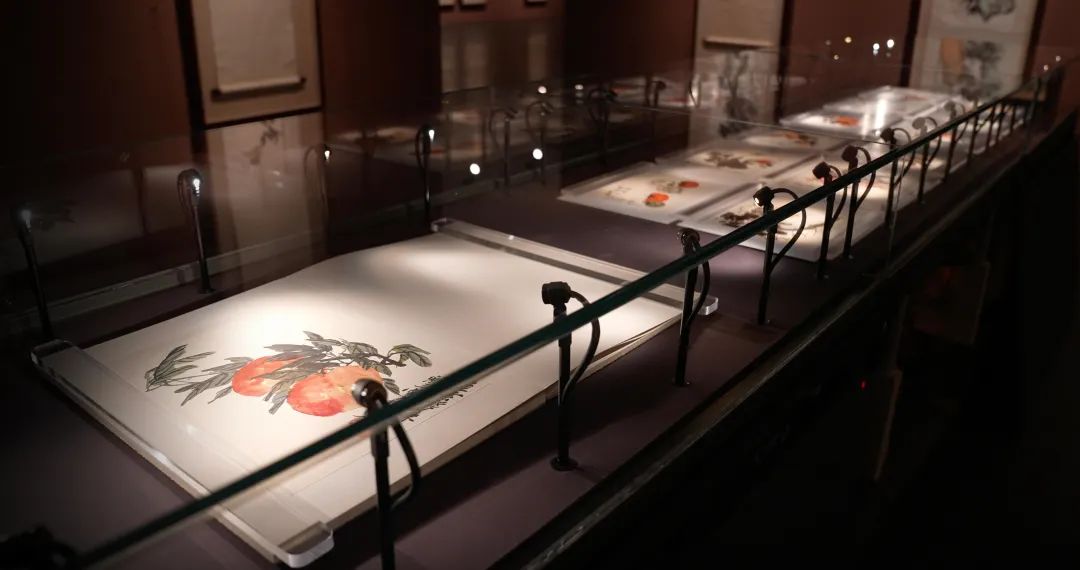
Ancient and modern Jinshi is under the eyes
■ Xujiang
About sixty years ago, Mr. Pan Tianshou served as the president of the Chinese Academy of Fine Arts. At that time, Mr. Pan Tianshou, Mr. Wu Yanzhi, Mr. Zhu Le San, and Lu Zifei taught Mr. Pan Tianshou. Several old gentlemen asked academics with peace of mind, often gathered academics, and discussed the best of arts, forming the style of harmony, and singing and singing, and cast the peak phenomenon of traditional Chinese painting research and teaching at that time. When I was in college, Mr. Zhu Le San was still healthy. It was just that I was far -reaching at that time, and I hadn't fully insight.

In the 1930s
Mr. Zhu Le San was born in his family, and his brothers are all happy. In his early years, he learned the doctor, and then abandoned the medical painting painting, and entered the door of a generation of master Wu Changshuo. Mr. Zhu is good at freehand flowers and birds, as well as the landscape, and he has the master of the teacher. The pen is deep and strong, and the ink color is fresh. On the basis of inheriting the Lugu School of Poetry and Sketching, there are breakthroughs and new technical themes, and it is very important to stand in Qiantang and be valued by the world. Mr. Zhu can be called a generation of seal masters. His seal engraving is seal with oracle words, and it is turned out from the ancient seals of the Qin and Han dynasties. Between the lines, the clusters of the cluster, the horizontal and horizontal elephant, the reality and the reality, and the vast. Mr.'s calligraphy, the teacher went out of the elderly of the Lugu, and changed his teacher, and he was a long -sighted teacher. Press the thickness to condense. The poems are caused by the Tang style, and the heart is cut out.
Mr. Zhu Le San's paintings have a deeper spirit of excellence. When "Wenfu" was talking about the pen, it said: Shen Ci Yueyue, if the fish titles are hooking and the depth of the alarm; Shen, Shen Ye! The deep words are like spring, and the fish titles come out, out of the depth of Zhongyuan. This is exactly the vivid portrayal of deep. Deep but not stagnant, the heart is good, the intention and words are in harmony, and the heart is in the heart, and the birth and deep harmony. This is exactly the freehand of flowers and birds. "Heaven? Four o'clock, everything is born, what is the heavens?" Chinese flowers and birds painting, with the common seasons, will have the flowers and trees that should be born from time to time. The frustration of the pen under the pen, applying it, making people meet with everything here. Mr. Zhu's flowers and birds, red plums, wisteria Shuangyan, rice flowers fragrant, lotus ponds, pine and bamboo, wind bamboo and orchid, although it is the normal wind season, through his hands, the pen in the pen is with the pen. A pride. The deserted oil cloud, there are few long winds, it becomes a deep meaning, a kind of vitality overflowing at the pen. If it is a deep weather, it turns into a strong sense of the picture. Mr. Zhu's painting is so old -fashioned, most like he is using a thick pen here. Almost from the beginning, he was able to apply the method of Yili to the painting. Although youthful and arrogant, his pen is thick and unique. The sixty years of the wind and rain, the more healthy, the stronger the Mr. Zhu, the stronger. The flowers and trees in his pen are often turned into a combination of coils, Li, and Crazy grass to write a winding gesture. The inner bone force of this calligraphy, the wind is brought out of the grass, leakage is often left in the sprinkler, which always shows the vast and mighty weather. Chinese painting emphasizes calligraphy into painting. Mr. Wu Changshuo is the peak of modern times.
Mr. Zhu Le San in the 1970s waved in the studio

Mr. Zhu's favorite old verse is his lotus title sentence: Mochi Dian Dian Qiu Mingming, bitter iron painting gas does not draw shape. Why is Qiu Mingming, because there is a vast air in it. Like the ancient Chinese monument of Chinese, ancient Mao Cang was gloomy. The simple and elastic style of the Chinese is the most hidden in this new flowers and grass. It can be seen that the real life of this flowers and grass lies in this spiritual style. Mr. Zhu has one seal, engraved with "beauty is not old". Beauty will not grow old. Meizheng is in the ancient style of muddy. In this regard, the rhetoric of Chinese books and seal gave him too much nourishment. In his life, he was in this simple ancient style.
In the spring of 1959, Mr. Zhu Wen "dared to do", and the side style: "Dare to think, dare to say, dare to do it, why not be unique to me." , I dare not live if I dare not. "Dare to find a breakthrough in dare not to find a breakthrough! In the late 1950s, Mr. Zhu gathered passionately, posted on the pen, painted all the flowers and birds, and created the writer to ask the spring. His pen and ink turned and free. The color of the color is gradually gorgeous, the fun, and the wind is sparse, expressing the promise of the new era.
In 1971, the three couples of Zhule were taken on the banks of Xizi Lake
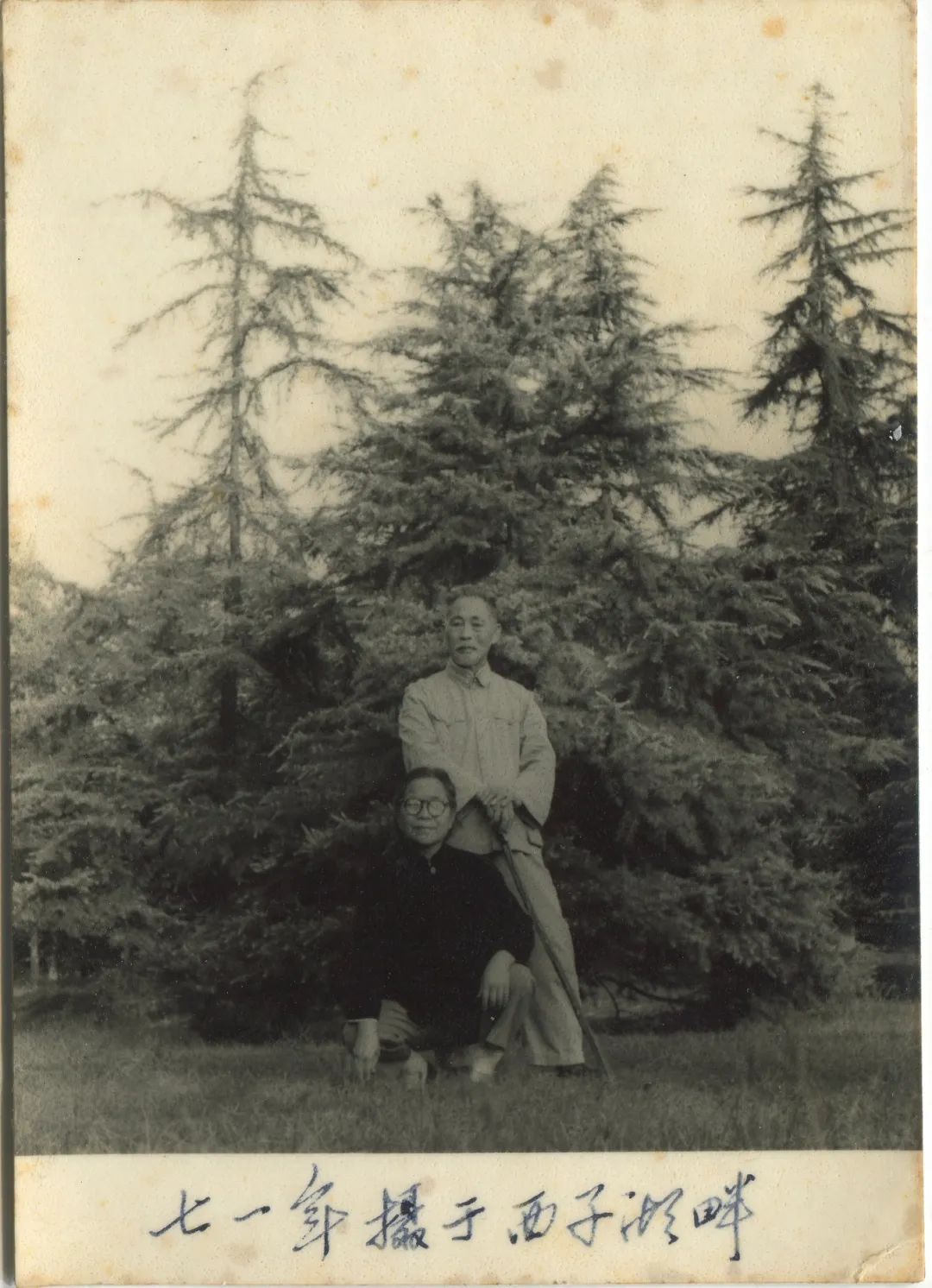
The generation of Mr. Zhu, when he was young, just stood on the port of the old school alternation of the old learning around the Fourth Around May 4th. He studied medicine as a science class, but his art is dazzling, and his hands are happy. But writing poems is the kung fu of teenagers. At the age of eleven, Mr. Ying's poem "Sunrise" was sung casually: "Looking in front of the window, the east is full of redness." This is the poem, and it is also the vitality of the teenager. Mr. Zhu Le San's life is in this poetic and infiltration. In 1919, he was eighteen -year -old self -titled small shadow cloud: "Such a skeleton eye is green, and the wind and dust fall into the Confucian name. Whenever there is no constant mistakes, the career will finally lose. Gongtong. Nian Hua hurriedly passed, and he couldn't let the ancestors born in the first and nine. "Such a youthful reflection, if you ask, you can ask for it. The sketch of Mr. Zhu's generation is more poetry. Remember to see and feel the poem. Sitting in the right way, Cheng Huaiwei, and then the poem with quality. The painting is in the poetic thinking, and there is poetic meaning. I have a work from Mr. Zhu Xiaoxiang, Dongyang Shi Xiangxiang at hand. There is a hole in the sky, and it is endless.
We don't know much about Mr. Zhu Le San's generation. Fortunately, the "Three Years of the Music" is well -recorded and described in detail. It is read that we have seen the storms of Mr. Zhu, and because of the intersection with the Great Age, we often cover up. Mr. Zhu's pen and ink vicissitudes of his pen and ink are in front of him. The Dan Qing career of a generation of masters is endless. In December 1982, Xiling Yinshe published the "Indian Seal Collection". Among them, the road is clear, and the thoughts are smooth. In the "Wu Changshuo's Printing Preface": "When you can hold the stones, those who have the text of the ancient and modern gold and stones are in the eyes." Ancient wind portrait.
Mr. Zhu Le San in the 1970s was in the late Minglou apartment

Fanghua Changsang Holding Four Spring Spring
■ Gao Shiming
In the three thousand years of changes in the three thousand years, Zhu Le San has not only experienced the riots of the ideas of ancient and modern Chinese and Western thoughts, but also experienced the fierce changes in the humanistic concepts and aesthetic interest brought about by huge social changes. They adhere to the charm of traditional literati, and they have also established the professional ideals of modern artists and educators. On the one hand, they inherit the traditional arts and literatures of poetry, calligraphy, painting and printing, and are determined to assume the historical responsibilities of the inheritance of the national art system. On the other hand, they actively explore the visual expression of the new era and new society in the new historical situation. In artistic creation and professional teaching, they inherit tradition and continue the ancient roads, and at the same time come up with new and new bureaus. The historical tension has accumulated heavy tension. It is borrowed and sprayed in their calligraphy, painting, poems, and seal engraving. Chinese traditional art attaches great importance to the Pokémon and emphasizes the learning of people. Painting and calligraphy of all ages has been stated in poetry, calligraphy and painting, and learning and skills. Qian Mu once said when talking about "the learning of people", "Learning is expensive. If only painting theory, artistic theory of art, as well as the history of the scriptures and the history of literature and history. Limited to a string, there is no vision of all directions. "This" meeting "is an important characteristic of Mr. Zhu San in artistic creation and research. He said:" (engraved) without the strong skills of various physical calligraphy, just by relying on alone, just rely on alone The 'engraving' cannot be achieved. The cultivation without calligraphy will not have ink in the carving of the golden stone; in turn, in the painting and calligraphy, if there is no practical experience of golden stone engraving, the ancient golden stone atmosphere will not produce in calligraphy and painting. Between the four of them, they are on -. "
Zhule San Zhejiang Academy of Fine Arts 2.2 × 1.6cm 1972
Anji County Museum (Zhu Le San Art Museum) Collection
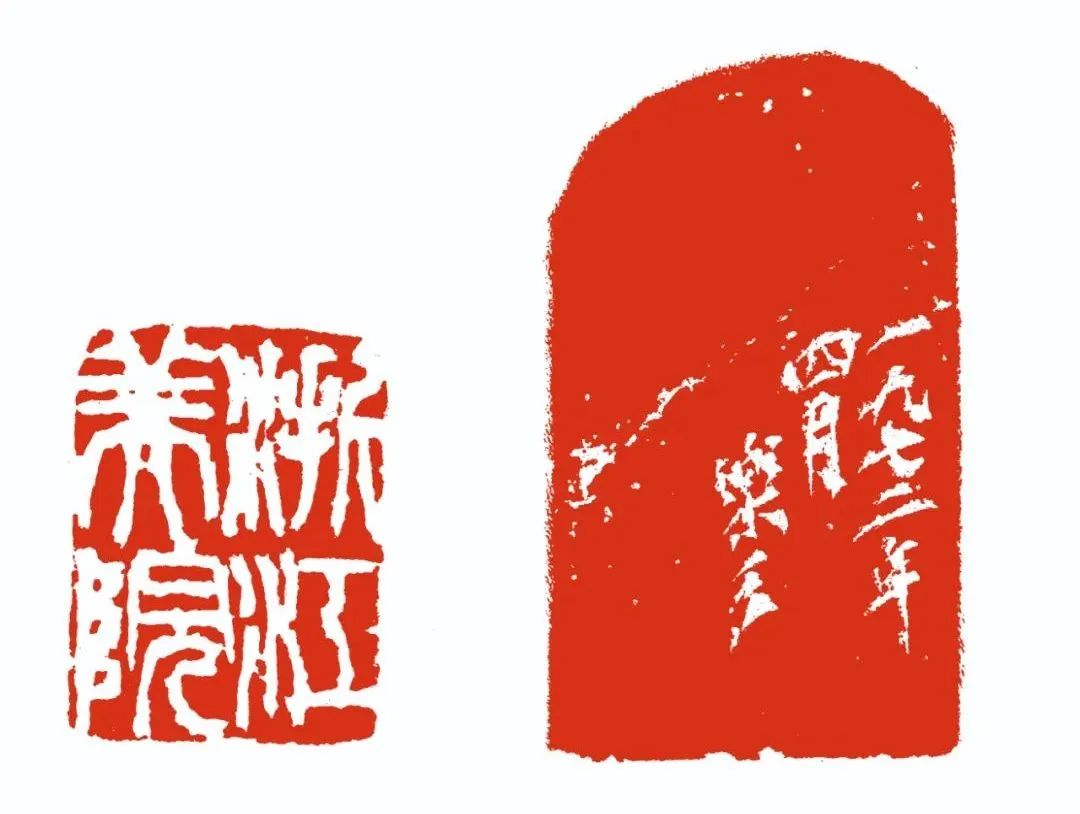
Seal: Zhejiang Academy of Fine Arts
Border model: April 1972, Le San
As a disciple of Mr. Wu Changshuo, in the four areas of poetry, books, paintings, and printing, Zhu Le San has been burned. The word "Le San" comes from Wu's suggestion. The so -called "benefit of the three music" by Confucius is "the joy of being a man, the joy of poetry, calligraphy and painting, and the joy of engraving." Mr. Zhu himself repeatedly emphasized in teaching: "Poems, books, paintings, and seals are based on each other. Therefore, those who learn scholars must also be poetry, painting, and engraving. Learn the seal. You can inspire each other, penetrate each other, and add each other. "
Mr. Zhu's poems are deeply accomplished, and he knows the way of calligraphy and painting. The poems of his inscriptions are not only clever, but also can be used as a point with the painting realm. The deep poetic cultivation allowed him to enter the painting with poetry, poetic and painting with each other, and the painting of paintings became higher and farther. Taste as "Discover Plum in the Snow", the ancient meaning is full of meaning, and the painting is full of painting:
The lone mountain is not lonely plums, and the cold vomiting flowers hold the heart. The Zhi Zhi was rigid, and the rigidity was not afraid of the wind and frost. The lake is rounded and light, shaking the flowers of flowers. The dragon and snake are stubborn and strong, and the caves are deep. It is like Yuping in the fragrant seal, and it shines on all sides. There are good words from time to time, but Mingyue knows the sound. When I came to the snow in the snow, I was in the cold. Open the chest and scream, and the puppets and emerald feathers.
Zhule Sanquan engraved 5 5 5 25.8 × 16.3cm 1923
Anji County Museum (Zhu Le San Art Museum) Collection
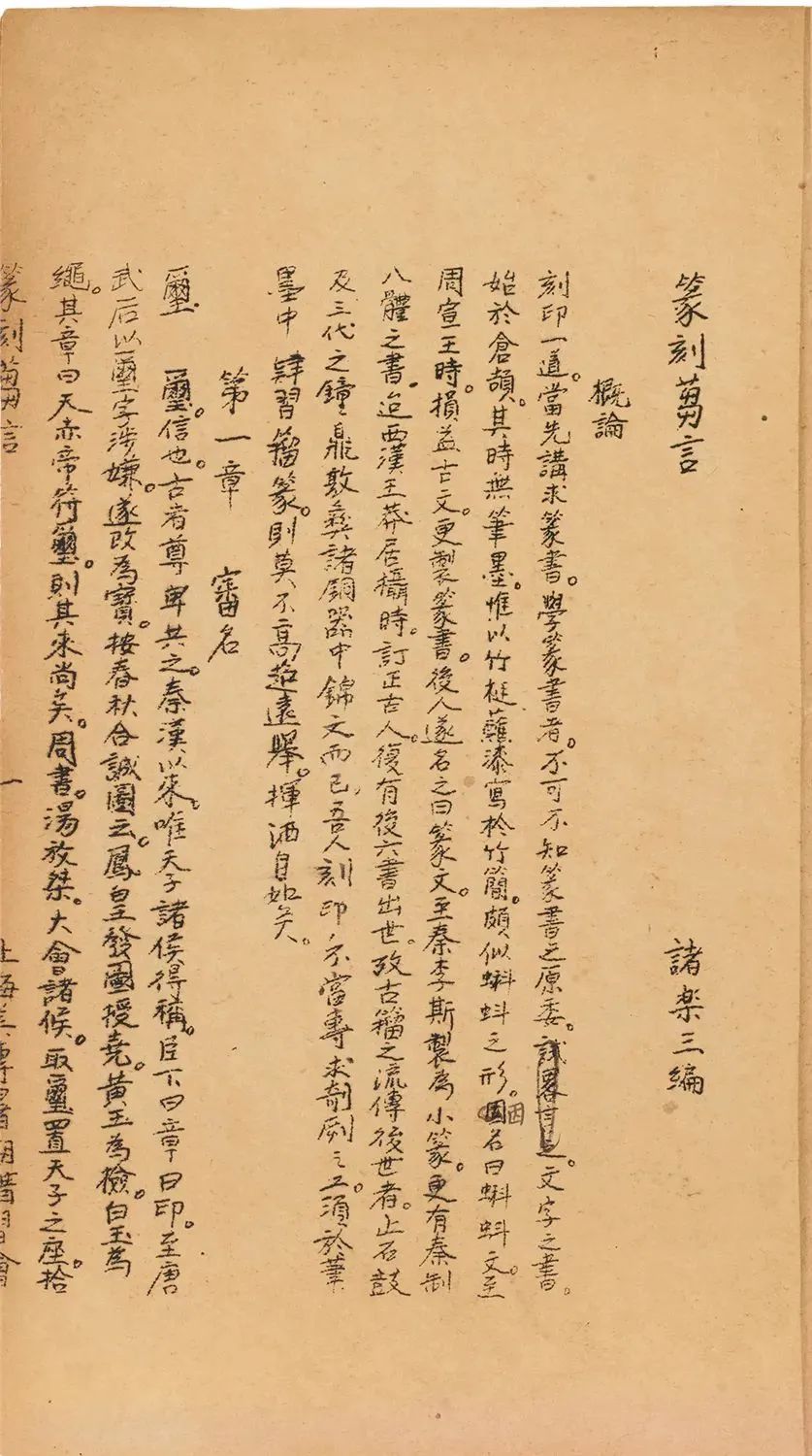
Mr. Zhu's regular script started from Zhong Yan, and Yu Yanliu had a lot of experience. He then turned to attack the Six Dynasties of the Han and Wei Dynasties. His book is chic and vigorous, clustering, and the body is steep, simple and simple, and the brushes are soft and rigid, and the back of the paper. The first study of the scholarship, Deng Shiru, Wu Dazhen, and then studied stone drums, and tauna bones and Zhong Ding, which was cast as Pu Mao and Mu's self -perspective. His achievements in calligraphy directly act directly on seal engraving, attracting oracle bones and golden texts in the Han seal. Du Jianzhong's dew.
Mr. Jin Jiancai described Mr. Zhu's seal: "In my memory, he often uses two words such as 'grouping' and 'Cang Cangxian'. Regardless of the distance, you must look forward to each other and take care of each other; the latter refers to the method of swords and brushwork, which requires a strong and ancient interest, and you should not be smooth. "
Zhule Sanzi Mongolian 121.9 × 44cm 1956
Chinese Academy of Fine Arts
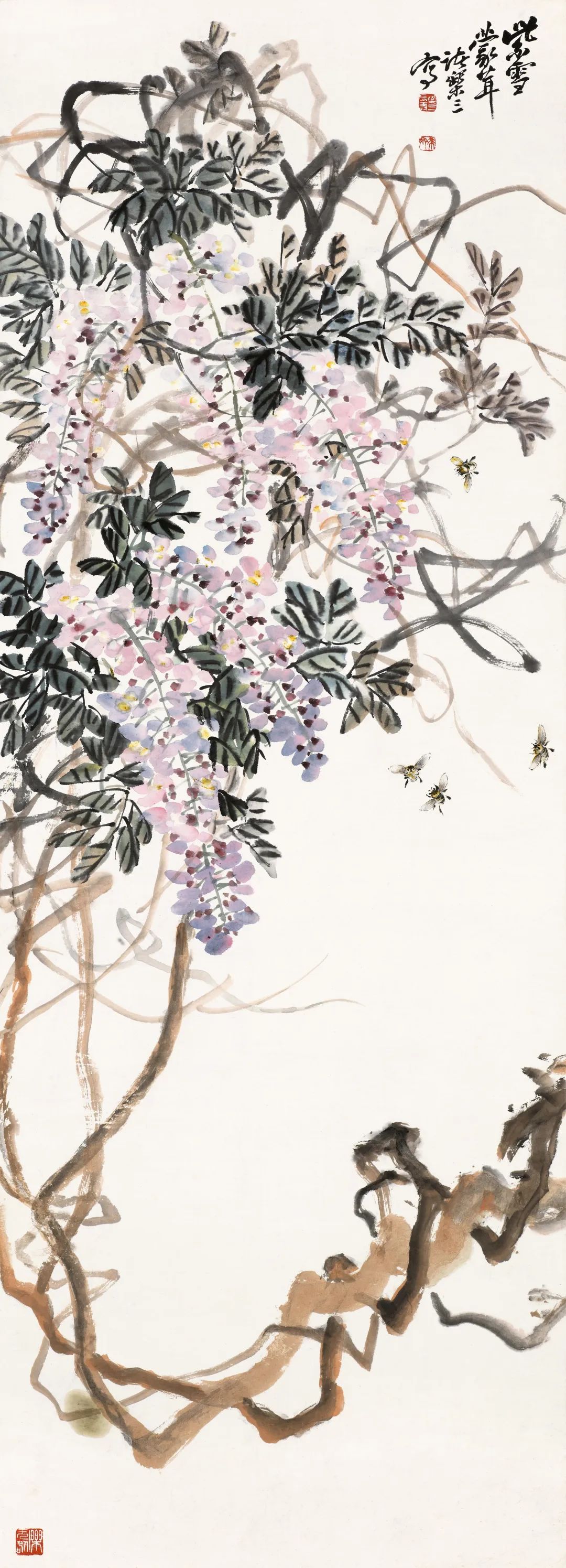
Compared with calligraphy engraving, Mr. Zhu Le San's paintings are more precocious. Wu Changshuo was engraved into painting with stone drums and seal, and Mr. Zhu was removed from his "golden stone flavor" in the inheritance of Wu's, and returned to the interest of traditional literati paintings. The transformation of Shi Tao, a wide range of expo. His representative works are all simple and spicy in ink and ink. He painted wisteria, with a brushwork that combined with the combination of seal, Li, and Crazy grass, to draw a winding gesture, with an orderlyness, thick and agile, calm and fresh and natural, just like his poem in his paintings: "The wind attracts vine flowers and dances, Lulu Lanfang. Spring sunlights in the mountains, and the pen is also fragrant." In terms of theme selection, Mr. Zhu broke through the common theme of the traditional literati painting plum bamboo chrysanthemum -style, and he chose the mountains. Shuiye Huai, fruits and vegetables and insects are painted. The corn flowers, white chicken tomatoes, rice ear cotton crusts in his pen ... not only expand the meaning and affection of flower and bird painting with local people's livelihood, but also from ordinary daily things. Send a halal and quaint humanity. Zhule three hundred flowers are placed 3.7 × 3.7cm 1960 in 1960
Anji County Museum (Zhu Le San Art Museum) Collection
Printing: Flowers bloom together

Bian: Flowers are blooming and new. Keep this word for literary artists. Le Carving, Gengzi Three days after the beginning of the autumn
The ancients who are known to be known in their lives, those who have learned, are more sleepy and known. This "knowing" was caused by the great dilemma of the great era. Mr. Zhu's calligraphy and seal carving have a good pattern of the past, and often have a sense of resistance. Mr. Zhu Le San's Broadcom is good at poetry, many talents condensed, and achieved his book. The ideal of his teaching is to rebuild the learning of "people" in Chinese classical contexts, and reconstruct the era of national painting creation and research. peak. He teaches calligraphy and seal engraving, pays attention to incorporating the study of text science, directly leads to the science of ancient text and golden stone literature, and connects creation and science, calligraphy and book theory. He taught Chinese painting and poetry inscriptions. Although it is different in different courses, he not only quotes the techniques of calligraphy engraving into painting, but also emphasizes the painting of painting. In teaching, he often borrows Wu Changshuo's words to teach students, "Read thousands of books, walk thousands of miles, and can also be related to painting." In teaching, he often emphasizes: "different cultivation, different childhood, reading more books, reading more books, more reading more, more reading, more reading, more reading. You can get Qi Qi, and the tacky qi is eliminated. " In his opinion, reading and raising his mind is the key to artistic creation and the main purpose of art education. At the same time, the way of calligraphy and painting is by no means stop in the pen and ink, and the study, knowledge, experience, and action is the inherent support of art and literature. It is also the source of the painter's creation and self -containing family.
For Mr. Zhu Le San, the four of the poetry, calligraphy, calligraphy and printing are helping each other, and the triads of artists, scholars, and educators are also one and complement each other. He studied painting and calligraphy classics, and famous artists. He "started", brought the style of the new society and the spirit of the new era into the painting, and introduced the new and unpretentious style. He has not only undertaken various courses such as flowers, birds, calligraphy engraving, ancient texts, paintings, poems, etc., but also integrates in art and morality. As an educator, Mr. Zhu Le San coached for dozens of years. He played a pivotal role in the process of starting and reconstruction, pioneering and educated in Chinese painting and calligraphy engraving.
Zhu Le San and Huang Binhong sketching under the peak of Lingyin, the student Hong Shiqing took a photo for the two
In 1963, Mr. Zhu and Mr. Pan Tianshou, Lu Weizhao, and Sha Menghai jointly founded the first undergraduate calligraphy engraving major in the history of higher art education in New China. He was responsible for drafting the syllabus of seal engraving teaching, and taught scriptures and seal engraving. In 1979, with the age of nearly 80 years, he cooperated with Lu Weizhao and Sha Menghai to open a postgraduate education at the Zhejiang Academy of Fine Arts to open a new chapter for the history of Chinese education. The basic characteristics of the Gome Calligraphy majors are the academic framework of Boya and the blueprint of each discipline. The extension of the extension is cultural history, archeology, literature, history, and philosophy. It is especially important that Mr. Zhu and Lu and Sha Ergong include the oracle bone text into the learning object, and quote Dong Zuo Bin Yin's calligraphy "Five Phase" to learn five types of golden texts, such as Sanshi Pan, Xi Jiajia. The plate is a strong class, Dadu Ding and Shi Xun are graceful and elegant categories. The genus; the above -mentioned ancient texts are directly connected to Li and the scholarship. Due to the distant knowledge of your gentlemen, the calligraphy teaching of the Chinese Academy of Fine Arts has created a model of cultivating "people" since the birth of the calligraphy teaching, which is not only available in ancient Chinese characters, golden stone literature, and the study of history. The way. Among them, in 1953, in 1953, he wrote "Mr. Huang Binhong Painting Give Baimen Qingliang Mountain Residence Map":
Do not talk about pictures and texts, the painting is the meaning of the word.
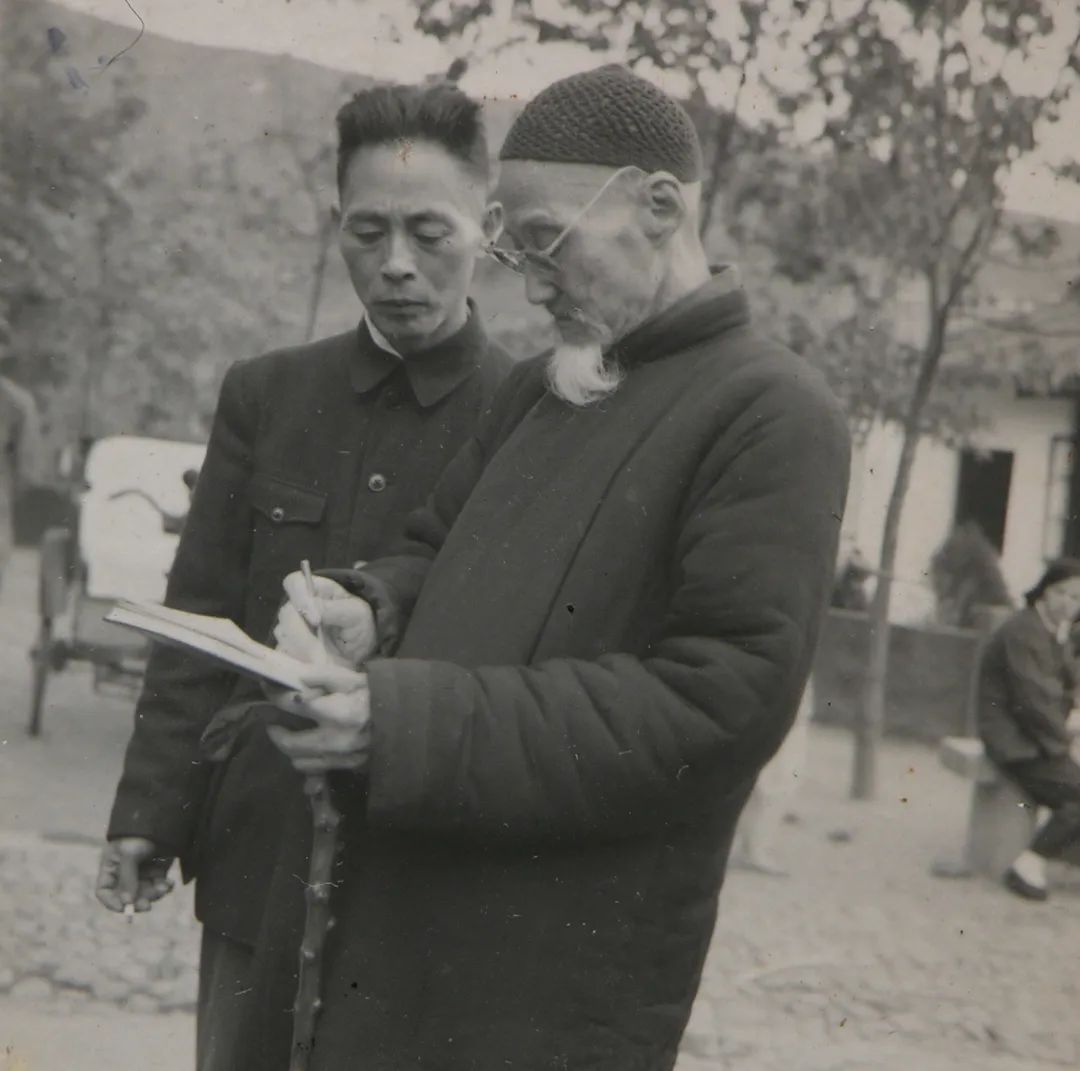
It is difficult to say in the middle of the world.
The ink stains are full of paper monuments, and the knowledgeable people laughed.
Laughing, Weng Boqi, brush and stagnation.
The mountains of the mountains and rivers set the wrist, and there are poems in the poem.
Huang Binhong Huang Binhong Preface to the Three "Seal Carvings" 25.8 × 16.3cm 1948
Anji County Museum (Zhu Le San Art Museum) Collection
Interpretation: From the Yuan Dynasty, Qiu Yan wrote "Thirty -Five", and there are many people who continue to talk about the law.By the time of the Qing Dao, Jin Shisheng, Weixian Chen Zhai made "India", Qianxi Wan Yin, the test interpretation of the department, and the end of it, scattered more.It was unearthed in antiquities today, Xi Yinyou, Mr. Le San will expand it from this, fortunately.In 1959, the eighty -fifth Binhong of Wuzi, Mr. Zhu wrote another poem to give Mr. Lu Yifei, and also revealed the feelings and minds of this generation of artists:
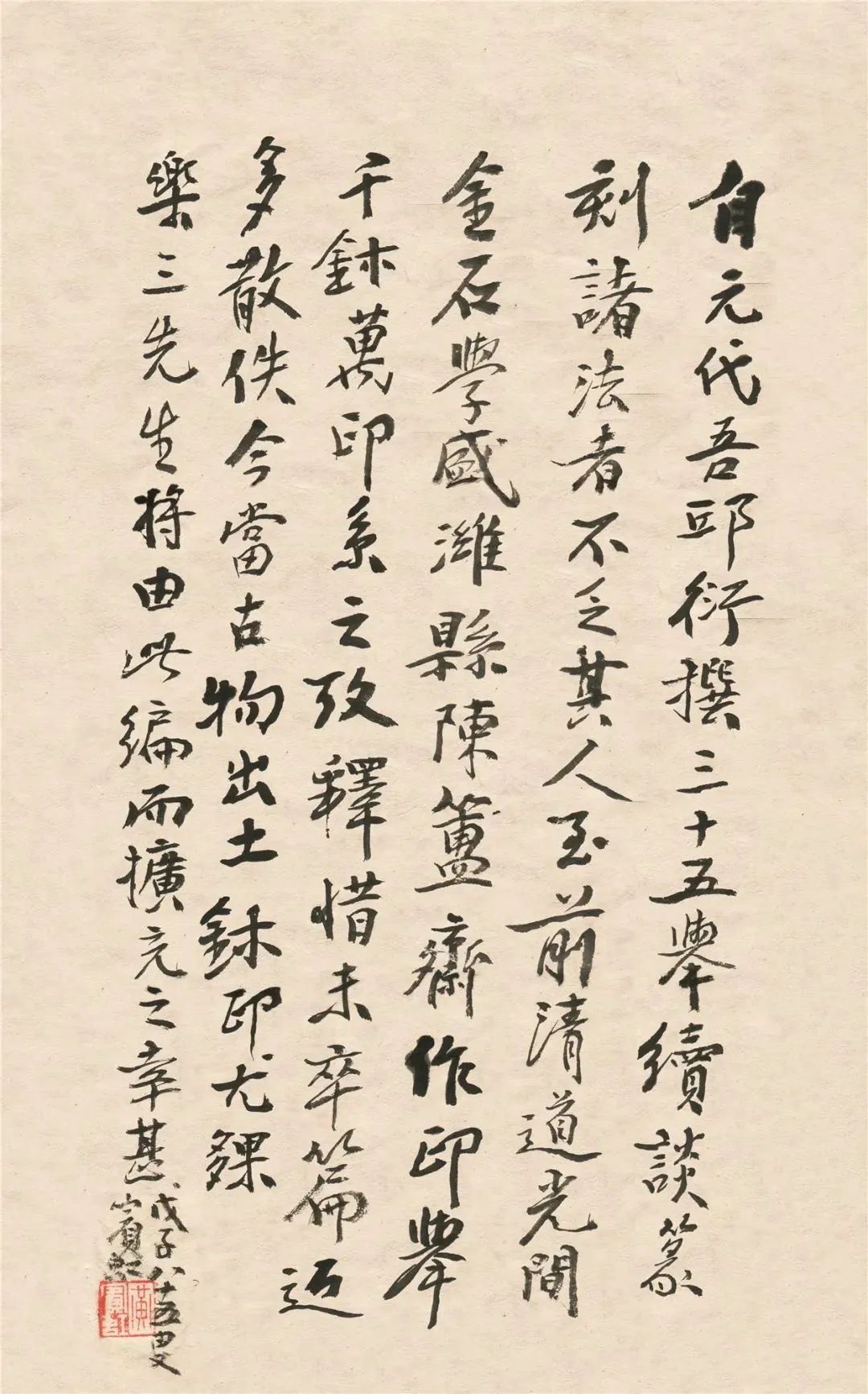
Some of them are intoxicated and new, and Dongfeng has its own gods.
Don't be afraid of wind, frost, ice, rain, and snow, Fang Hua is holding four -time spring.
(Selected from Gao Shiming "Fanghua Changsun Four Spring Spring -on the Bits of the 120th Anniversary of Mr. Zhu Le San's Birth")
Source | Art News
Editor | Zhou Xuanzhang Xing Sidie
Responsible editor | Liu Yang
Final Trial | Xu Yuan
Submit mailbox: [email protected]
Produced:
Propaganda Department of the Party Committee of China Academy of Fine Arts
Publicity Office of the CPC CAA Community
News Center of China Academy of Fine Arts
CAA News Center
CAA Rong Media Studio
CAA Media Convergence Center

- END -
How many can you recognize the Tao Wen symbol at the Erlitou site?
Video/Snapshot, T_100, F_JPG, M_fast Controls = Controls data-version/ueditor/video/mp4/20220813/1660400385701549.mp4 transcoding = 1 style = width: 400px; The Erlitou site is a repres
The red and hot "Hehe City" strolls lively
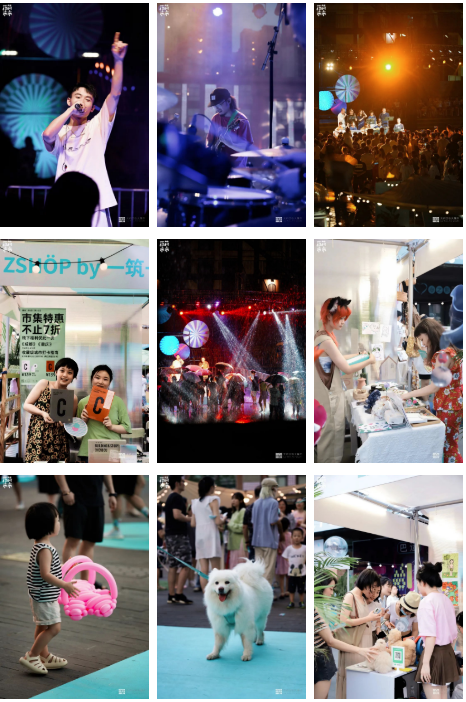
This weekend, 2022 Tianfu Cultural and Creative Bazaar opened on the East Suburbs ...